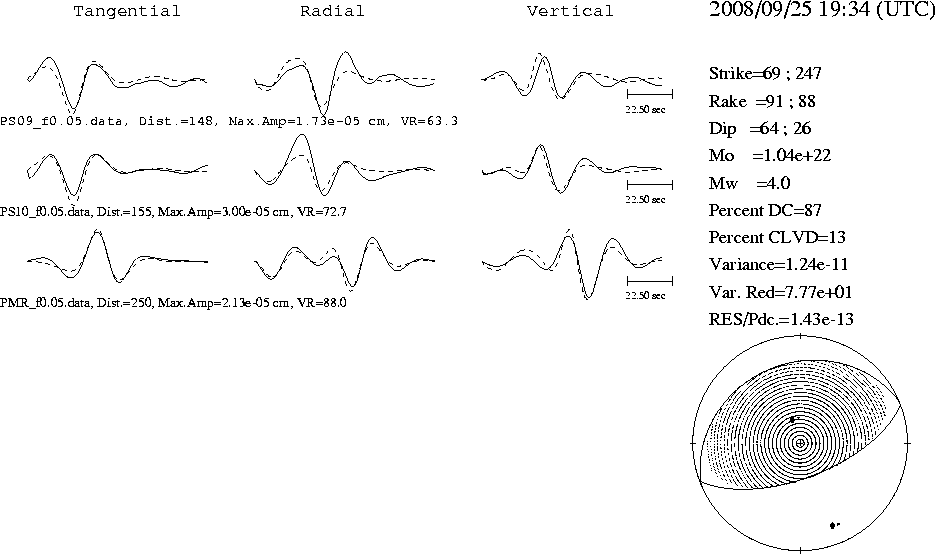Location
Location ANSS
The ANSS event ID is ak008cd72w8v and the event page is at
https://earthquake.usgs.gov/earthquakes/eventpage/ak008cd72w8v/executive.
2008/09/25 19:34:07 63.845 -148.744 10.7 3 Alaska
Focal Mechanism
USGS/SLU Moment Tensor Solution
ENS 2008/09/25 19:34:07:0 63.85 -148.74 10.7 3.0 Alaska
Stations used:
AK.BPAW AK.MCK AK.PAX AK.SWD AK.TRF AT.PMR IU.COLA US.EGAK
Filtering commands used:
hp c 0.02 n 3
lp c 0.05 n 3
Best Fitting Double Couple
Mo = 1.06e+22 dyne-cm
Mw = 3.95
Z = 15 km
Plane Strike Dip Rake
NP1 70 65 85
NP2 262 25 101
Principal Axes:
Axis Value Plunge Azimuth
T 1.06e+22 70 330
N 0.00e+00 5 72
P -1.06e+22 20 164
Moment Tensor: (dyne-cm)
Component Value
Mxx -7.68e+21
Mxy 1.96e+21
Mxz 6.24e+21
Myy -4.08e+20
Myz -2.69e+21
Mzz 8.08e+21
--------------
----------------------
--------------##------------
-------##################-----
------########################----
----##############################--
---#################################--
---############# #####################
--############## T ###################--
--############### #################-----
-##################################-------
-################################---------
##############################------------
#########################---------------
#####################-------------------
----#######---------------------------
------------------------------------
----------------------------------
------------------ ---------
----------------- P --------
-------------- -----
--------------
Global CMT Convention Moment Tensor:
R T P
8.08e+21 6.24e+21 2.69e+21
6.24e+21 -7.68e+21 -1.96e+21
2.69e+21 -1.96e+21 -4.08e+20
Details of the solution is found at
http://www.eas.slu.edu/eqc/eqc_mt/MECH.NA/20080925193407/index.html
|
Preferred Solution
The preferred solution from an analysis of the surface-wave spectral amplitude radiation pattern, waveform inversion or first motion observations is
STK = 70
DIP = 65
RAKE = 85
MW = 3.95
HS = 15.0
The NDK file is 20080925193407.ndk
The waveform inversion is preferred.
Moment Tensor Comparison
The following compares this source inversion to those provided by others. The purpose is to look for major differences and also to note slight differences that might be inherent to the processing procedure. For completeness the USGS/SLU solution is repeated from above.
| SLU |
AEIC |
USGS/SLU Moment Tensor Solution
ENS 2008/09/25 19:34:07:0 63.85 -148.74 10.7 3.0 Alaska
Stations used:
AK.BPAW AK.MCK AK.PAX AK.SWD AK.TRF AT.PMR IU.COLA US.EGAK
Filtering commands used:
hp c 0.02 n 3
lp c 0.05 n 3
Best Fitting Double Couple
Mo = 1.06e+22 dyne-cm
Mw = 3.95
Z = 15 km
Plane Strike Dip Rake
NP1 70 65 85
NP2 262 25 101
Principal Axes:
Axis Value Plunge Azimuth
T 1.06e+22 70 330
N 0.00e+00 5 72
P -1.06e+22 20 164
Moment Tensor: (dyne-cm)
Component Value
Mxx -7.68e+21
Mxy 1.96e+21
Mxz 6.24e+21
Myy -4.08e+20
Myz -2.69e+21
Mzz 8.08e+21
--------------
----------------------
--------------##------------
-------##################-----
------########################----
----##############################--
---#################################--
---############# #####################
--############## T ###################--
--############### #################-----
-##################################-------
-################################---------
##############################------------
#########################---------------
#####################-------------------
----#######---------------------------
------------------------------------
----------------------------------
------------------ ---------
----------------- P --------
-------------- -----
--------------
Global CMT Convention Moment Tensor:
R T P
8.08e+21 6.24e+21 2.69e+21
6.24e+21 -7.68e+21 -1.96e+21
2.69e+21 -1.96e+21 -4.08e+20
Details of the solution is found at
http://www.eas.slu.edu/eqc/eqc_mt/MECH.NA/20080925193407/index.html
|
|

|
Moment tensor inversion summary for event 2008/09/25 19:34
Date: 2008/09/25
Time: 19:34 (UTC)
Region: Central Region of Alaska
Mw=4.0
Location:
Lat. 63.8273; Lon. -148.7596; Depth 15 km
(Best-fitting depth from moment tensor inversion)
Solution quality: good;
Number of stations = 3
Best Double Couple:
strike dip rake
Plane 1: 69.3 63.6 91.1
Plane 2: 246.9 26.4 87.9
Moment Tensor Parameters:
Mo = 1.03529e+22 dyn-cm
Mxx = -0.69; Mxy = 0.25; Mxz = 0.59
Myy = -0.17; Myz = -0.21; Mzz = 0.86
Principal Axes:
value azimuth plunge
T: 1.07 341.63 71.38
N: -0.07 248.83 0.94
P: -1.00 158.51 18.59
|

|
Magnitudes
Given the availability of digital waveforms for determination of the moment tensor, this section documents the added processing leading to mLg, if appropriate to the region, and ML by application of the respective IASPEI formulae. As a research study, the linear distance term of the IASPEI formula
for ML is adjusted to remove a linear distance trend in residuals to give a regionally defined ML. The defined ML uses horizontal component recordings, but the same procedure is applied to the vertical components since there may be some interest in vertical component ground motions. Residual plots versus distance may indicate interesting features of ground motion scaling in some distance ranges. A residual plot of the regionalized magnitude is given as a function of distance and azimuth, since data sets may transcend different wave propagation provinces.
ML Magnitude

Left: ML computed using the IASPEI formula for Horizontal components. Center: ML residuals computed using a modified IASPEI formula that accounts for path specific attenuation; the values used for the trimmed mean are indicated. The ML relation used for each figure is given at the bottom of each plot.
Right: Residuals from new relation as a function of distance and azimuth.

Left: ML computed using the IASPEI formula for Vertical components (research). Center: ML residuals computed using a modified IASPEI formula that accounts for path specific attenuation; the values used for the trimmed mean are indicated. The ML relation used for each figure is given at the bottom of each plot.
Right: Residuals from new relation as a function of distance and azimuth.
Context
The left panel of the next figure presents the focal mechanism for this earthquake (red) in the context of other nearby events (blue) in the SLU Moment Tensor Catalog. The right panel shows the inferred direction of maximum compressive stress and the type of faulting (green is strike-slip, red is normal, blue is thrust; oblique is shown by a combination of colors). Thus context plot is useful for assessing the appropriateness of the moment tensor of this event.
Waveform Inversion using wvfgrd96
The focal mechanism was determined using broadband seismic waveforms. The location of the event (star) and the
stations used for (red) the waveform inversion are shown in the next figure.

|
|
Location of broadband stations used for waveform inversion
|
The program wvfgrd96 was used with good traces observed at short distance to determine the focal mechanism, depth and seismic moment. This technique requires a high quality signal and well determined velocity model for the Green's functions. To the extent that these are the quality data, this type of mechanism should be preferred over the radiation pattern technique which requires the separate step of defining the pressure and tension quadrants and the correct strike.
The observed and predicted traces are filtered using the following gsac commands:
hp c 0.02 n 3
lp c 0.05 n 3
The results of this grid search are as follow:
DEPTH STK DIP RAKE MW FIT
WVFGRD96 0.5 255 65 -10 3.82 0.4392
WVFGRD96 1.0 255 55 -5 3.88 0.4413
WVFGRD96 2.0 250 45 -5 3.95 0.4198
WVFGRD96 3.0 235 35 -5 3.96 0.4074
WVFGRD96 4.0 215 20 -20 3.93 0.4488
WVFGRD96 5.0 210 20 -20 3.90 0.4902
WVFGRD96 6.0 185 20 15 3.95 0.5285
WVFGRD96 7.0 195 20 25 3.92 0.5589
WVFGRD96 8.0 205 20 40 3.92 0.5801
WVFGRD96 9.0 230 20 65 3.91 0.6020
WVFGRD96 10.0 230 20 70 3.95 0.6155
WVFGRD96 11.0 240 20 80 3.95 0.6271
WVFGRD96 12.0 250 25 90 3.95 0.6358
WVFGRD96 13.0 70 65 90 3.95 0.6441
WVFGRD96 14.0 70 65 85 3.96 0.6448
WVFGRD96 15.0 70 65 85 3.95 0.6475
WVFGRD96 16.0 255 25 95 3.94 0.6459
WVFGRD96 17.0 70 65 85 3.95 0.6443
WVFGRD96 18.0 70 65 90 3.94 0.6425
WVFGRD96 19.0 260 25 100 3.95 0.6375
WVFGRD96 20.0 70 65 90 3.97 0.6342
WVFGRD96 21.0 255 25 95 3.97 0.6301
WVFGRD96 22.0 70 65 90 3.97 0.6264
WVFGRD96 23.0 70 65 95 3.97 0.6205
WVFGRD96 24.0 245 25 85 3.97 0.6150
WVFGRD96 25.0 235 25 75 3.97 0.6088
WVFGRD96 26.0 240 25 80 3.98 0.6031
WVFGRD96 27.0 235 30 80 3.98 0.5973
WVFGRD96 28.0 225 30 70 3.98 0.5913
WVFGRD96 29.0 235 30 80 3.99 0.5849
WVFGRD96 30.0 225 30 70 3.99 0.5786
WVFGRD96 31.0 235 30 75 3.99 0.5721
WVFGRD96 32.0 235 30 75 4.00 0.5656
WVFGRD96 33.0 235 30 75 4.00 0.5594
WVFGRD96 34.0 235 30 75 4.01 0.5525
WVFGRD96 35.0 235 30 75 4.02 0.5460
WVFGRD96 36.0 235 30 75 4.02 0.5384
WVFGRD96 37.0 230 35 75 4.03 0.5313
WVFGRD96 38.0 240 35 80 4.04 0.5232
WVFGRD96 39.0 230 35 75 4.05 0.5147
WVFGRD96 40.0 240 30 80 4.17 0.5070
WVFGRD96 41.0 240 30 80 4.17 0.4996
WVFGRD96 42.0 240 30 80 4.18 0.4926
WVFGRD96 43.0 240 30 80 4.18 0.4847
WVFGRD96 44.0 240 30 80 4.18 0.4771
WVFGRD96 45.0 240 30 80 4.19 0.4693
WVFGRD96 46.0 245 30 85 4.20 0.4613
WVFGRD96 47.0 245 30 85 4.20 0.4538
WVFGRD96 48.0 245 30 85 4.20 0.4462
WVFGRD96 49.0 245 35 85 4.21 0.4385
WVFGRD96 50.0 245 35 85 4.21 0.4313
The best solution is
WVFGRD96 15.0 70 65 85 3.95 0.6475
The mechanism corresponding to the best fit is

|
|
Figure 1. Waveform inversion focal mechanism
|
The best fit as a function of depth is given in the following figure:

|
|
Figure 2. Depth sensitivity for waveform mechanism
|
The comparison of the observed and predicted waveforms is given in the next figure. The red traces are the observed and the blue are the predicted.
Each observed-predicted component is plotted to the same scale and peak amplitudes are indicated by the numbers to the left of each trace. A pair of numbers is given in black at the right of each predicted traces. The upper number it the time shift required for maximum correlation between the observed and predicted traces. This time shift is required because the synthetics are not computed at exactly the same distance as the observed, the velocity model used in the predictions may not be perfect and the epicentral parameters may be be off.
A positive time shift indicates that the prediction is too fast and should be delayed to match the observed trace (shift to the right in this figure). A negative value indicates that the prediction is too slow. The lower number gives the percentage of variance reduction to characterize the individual goodness of fit (100% indicates a perfect fit).
The bandpass filter used in the processing and for the display was
hp c 0.02 n 3
lp c 0.05 n 3

|
|
Figure 3. Waveform comparison for selected depth. Red: observed; Blue - predicted. The time shift with respect to the model prediction is indicated. The percent of fit is also indicated. The time scale is relative to the first trace sample.
|

|
|
Focal mechanism sensitivity at the preferred depth. The red color indicates a very good fit to the waveforms.
Each solution is plotted as a vector at a given value of strike and dip with the angle of the vector representing the rake angle, measured, with respect to the upward vertical (N) in the figure.
|
A check on the assumed source location is possible by looking at the time shifts between the observed and predicted traces. The time shifts for waveform matching arise for several reasons:
- The origin time and epicentral distance are incorrect
- The velocity model used for the inversion is incorrect
- The velocity model used to define the P-arrival time is not the
same as the velocity model used for the waveform inversion
(assuming that the initial trace alignment is based on the
P arrival time)
Assuming only a mislocation, the time shifts are fit to a functional form:
Time_shift = A + B cos Azimuth + C Sin Azimuth
The time shifts for this inversion lead to the next figure:

The derived shift in origin time and epicentral coordinates are given at the bottom of the figure.
Velocity Model
The CUS.model used for the waveform synthetic seismograms and for the surface wave eigenfunctions and dispersion is as follows
(The format is in the model96 format of Computer Programs in Seismology).
MODEL.01
CUS Model with Q from simple gamma values
ISOTROPIC
KGS
FLAT EARTH
1-D
CONSTANT VELOCITY
LINE08
LINE09
LINE10
LINE11
H(KM) VP(KM/S) VS(KM/S) RHO(GM/CC) QP QS ETAP ETAS FREFP FREFS
1.0000 5.0000 2.8900 2.5000 0.172E-02 0.387E-02 0.00 0.00 1.00 1.00
9.0000 6.1000 3.5200 2.7300 0.160E-02 0.363E-02 0.00 0.00 1.00 1.00
10.0000 6.4000 3.7000 2.8200 0.149E-02 0.336E-02 0.00 0.00 1.00 1.00
20.0000 6.7000 3.8700 2.9020 0.000E-04 0.000E-04 0.00 0.00 1.00 1.00
0.0000 8.1500 4.7000 3.3640 0.194E-02 0.431E-02 0.00 0.00 1.00 1.00
Last Changed Sun Apr 28 01:02:28 PM CDT 2024










